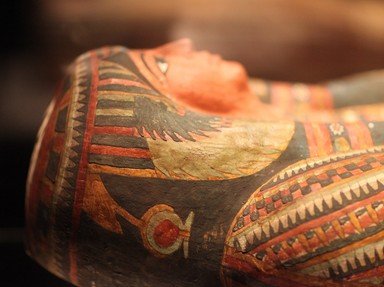Quiz Answer Key and Fun Facts
1. The man who would later rule as Akhenaten was named Amunhotep at birth. His father was a pharaoh of Egypt's powerful Eighteenth Dynasty; his mother was not a concubine, but rather the Great Royal Wife, wielding substantial power in her role. Who were this child's parents?
2. On the death of his older brother, Crown Prince Thutmose (now best known for the sarcophagus of his pet cat), the future Akhenaten was unexpectedly next in line to the throne. What step is his father thought to have taken to prepare him for pharaohdom?
3. The future Akhenaten clearly spent much of the early part of his reign planning the upheaval of the old religious order, but one tradition he had no trouble with was that of the pharaoh having multiple wives. It is, however, his main wife who has captured the imagination of the modern world. Who was his Great Royal Wife, a woman of legendary beauty?
4. In Year 4 of his reign, Amunhotep IV launched religious reforms that would change the heart of Egyptian life. Breaking with hundreds of years of worship of gods like Amun, Ra, and Osiris, the pharaoh decreed that his god -- the Aten -- was supreme. In the traditional religion of ancient Egypt, who was the Aten?
5. In Year 5 of his reign, the pharaoh made still more bold changes. He changed his own name from Amunhotep IV to Akhenaten ("Servant of the Aten") and made arrangements to move his capital to a completely new location, one untainted by the old gods. He named his capital Akhetaten, "Horizon of the Aten." What is the modern name of this planned city?
6. In Year 9 of his reign, Akhenaten decided to raise the stakes. No longer arguing that the Aten was merely the supreme god of the Egyptian pantheon, he declared that the Aten was the _only_ god. He banned all idols except for the symbol, surrounded by rays of light, that represented his god. In the art of the time, with what did the rays of light commonly end?
7. The art of Akhenaten's reign is vibrant and distinctive. Portraits of the royal family showed them in natural poses, even going so far as to demonstrate affection for each other! The portrayals of Akhenaten himself are particularly unusual. How was he represented in art?
8. Akhenaten's later reign was marred by a plague that struck both Amarna and the whole of Egypt before spreading to the rest of the Middle East. At least two of his youngest daughters perished in the pandemic, along with the king of what nation opposed to Egypt?
9. Despite important events in foreign and domestic politics, Akehnaten is best remembered for his dramatic reform of his nation's religion. Did his reforms endure beyond his death?
10. In the last century, some scholars have been eager to assign Atenism greater influence than there is direct evidence for. Headed by Ahmed Osman, some even argue that Akhenaten himself was one and the same as what major figure of monotheist religious history, a man who is traditionally associated with Egypt?
Source: Author
CellarDoor
This quiz was reviewed by FunTrivia editor
DakotaNorth before going online.
Any errors found in FunTrivia content are routinely corrected through our feedback system.

